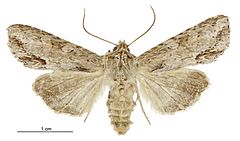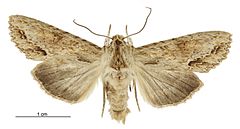Graphania mollis facts for kids
Quick facts for kids Graphania mollis |
|
|---|---|
 |
|
| Female | |
 |
|
| Male | |
| Scientific classification | |
| Kingdom: | |
| Phylum: | |
| Class: | |
| Order: | |
| Family: | |
| Genus: | |
| Species: |
G. mollis
|
| Binomial name | |
| Graphania mollis (Howes, 1908)
|
|
| Synonyms | |
|
|
The Graphania mollis is a type of moth that belongs to the Noctuidae family. These moths are often called "owlet moths" because many of them fly at night. This particular moth was first described in 1908 by a scientist named George Howes. He found specimens of this moth in places like Otago and Southland in New Zealand.
This moth is special because it is endemic to New Zealand. This means it can only be found naturally in New Zealand and nowhere else in the world!
Contents
About the Graphania mollis Moth
The Graphania mollis moth is a fascinating insect. Like all moths, it starts its life as a tiny egg, then hatches into a larva (a caterpillar), which then turns into a pupa, and finally emerges as an adult moth. Adult moths have wings and can fly, helping them find food and mates.
What it Looks Like
Looking at the pictures, you can see that the Graphania mollis moth has wings that are mostly brown or grayish-brown. They often have interesting patterns or markings on their wings that help them blend in with their surroundings, like tree bark or leaves. This camouflage helps them hide from predators. The female and male moths might look a little different in size or color, as shown in the images.
Its Scientific Name Story
When George Howes first described this moth in 1908, he gave it the scientific name Melanchra mollis. Scientific names are important because they give every living thing a unique name that scientists all over the world can understand.
Over time, scientists learn more about different species. In 2019, a scientist named Robert J. B. Hoare did a big study of the owlet moths in New Zealand. After carefully looking at the original moths Howes described, Hoare decided that Graphania mollis actually fit better into a different group, or "genus," called Ichneutica. So, its scientific name was updated to Ichneutica mollis. This shows how science is always growing and changing as we discover new information!
Images for kids



